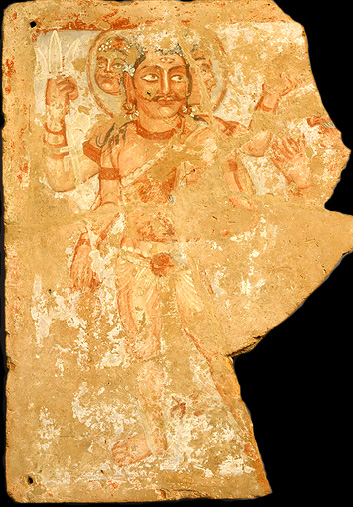

The name Kushan is derived from the term Guishang, used in Chinese historical writings to describe one branch of the nomadic people, called Yuezhi or Yuechi. These nomads who were of Indo-European stock, roamed the northwestern China but during 176-160 BC, they were driven west by another group, the Xiongnu. The political disturbance in central asia (and possibly the availability of better and prosperous land and other resources) drove these nomads out into Bactria (modern (northwest Afghanistan and Tajikistan). In 165 BC, few tribes settled in Oxus valley and established independent existance. Kujula Kadphises (30-80 AD) established the Kushan dynasty in 78 AD by taking advantage of disunion in existing dynasty of Pahalava (Parthian) and Scytho-Parthians, and gradually wrested control of southern prosperous region, which is the northwest part of ancient India, traditionally known as Gandhara (now Pakistan).
It was his grandson Vima Kadphises (Yen-kao-chen in Chinese record) who made Kushan a paramount power of northern India. His reign saw emergence of Kushan empire when he conquored north-western India (modern Punjab, now divided in Pakistan and India). Kushan empire covered north west of India (includes Pakistan and modern Afganistan) and northern India. Ample evidences of trade with China, cental Asia, Egypt and Rome are available which made their economy very strong and kingdom wealthy and prosperous. Soon he came under influence of `early' Hinduism and took opportunity to proclaim himself Mahishwara, another name for Lord Shiva, on his coins (Shiva is a prominent Hindu god). Kushan kings introduced gold and copper coins, a large number of them have survived till today. It was the Kushan emperor, Vima Kadaphises who introduced the FIRST gold coins of India. He minted gold coins in three different denominations; double Dinar, Dinar and quarter Dinar. Example of each of these three denominations are shown below. Vima mostly used one deity, Shiva (Oesho in Bactrian language) standing (with trident) with (or without) his bull Nandi, on reverse of his coins.
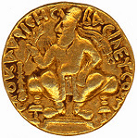
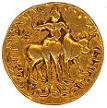
Vima Kadphises
110-128 AD
Gold Double Dinar, Possibly the FIRST GOLD COIN of India
Obverse: Bearded, diademed King, seated on high couch (throne) with feet resting on a
foot-stool, holding in right hand a twig or branch of spice plant, a club in foreground
to his right. His feet resting on foot-stool. The Greek (not Bactrian) legend
`Basileus Ooema Kadaphises’ starting at `I’ position. The Kushan symbol is in upper
right field.
Reverse: Naked Shiva standing, holding trident in right hand, standing with Nandi,
the bull. The Kharoshti legends Maharajasa rajadirajasa sarvalogaishwarasa Mahiishwarasa
Vima Kadaphisasa Tratara starting at XII position is around. Nandipada symbol is on left.
Weight: 15.75 gms
Reference: GK#11
Extremely Rare
Vima Kadphises
110-128 AD
Gold Dinar
Obverse: King emerging of clouds
Reverse: Shiva standing holding trident
Weight: 7.8 gm
Reference: GK#19
Scarce

Vima Kadphises
110-128 AD
Gold Quarter Dinar
Obverse: Bust of King looking through window, legend in Bactrian BACILEV(COOHMO) KADFICHC
Reverse: Trident, phallus and drum, Kushan symbol and Nanadipada in the left and right field
respectively, Kharoshti legends
Weight: 1.95 gm
Reference: GK#9.9
Rare
Undoubtedly all the Kushana emperors used their coinage for the propaganda of their own superiority and the possession of superhuman abilities! The concept of showing king/ruler on the coins was non-existant in India and all the previous dynasties minted coins showing only the symbols (punchmarked coins). It was the Kushan rulers who popularised this idea (borrowed and later modified from Indo-greek coins) which remained in use for another 2000 years. Kushan coinage were copied not only by later Indian dynasties like Guptas, but also by the neighbouring kings like Sassanians (of Persia). Unfortunately, very few evidences of Kushan rule survive today. Indeed Kushan coins are perhaps the best evidence we may have of this illustrious dynasty. Kushan coins tell great deal about the images of the kings as they wished to be seen by their subject. The portraits on Kushana gold/copper coins of Vima Kadphises are amazingly individualistic, often showing him full-bearded, big-nosed, fierce looking warrior chieftain, perhaps with deformed skull, wearing high helmet, tunic, overcoat and felt boots. Shown above is very good example of his coin where Vima is seen sacrificing at an altar. On reverse, Shiva and Nandi are seen. This was THE BEST numismatic icon ever been created in history of India. The concept of showing King on obverse and god/goddess from Hindu (rarely from Buddhist and Zorostraian) pantheon became so popular that it was used for more than 6 centuries in India on practically all the gold coins. Later, in modified form, it was used till 10th century AD. Vima like later Indo-Greek kings, also minted bilingual coins. The obverse of his coin had legends written in cursive Greek (Bactrian) while reverse showed legends in Sanskrit, written in ancient Indian script, Kharoshti. On reverse, the Kharoshti legends reads `Maharajasa Rajadhirajasa Sarvaloka Ishwarasa Mahishwarasa, Vimma Kadaphisasha Tratara'. The legend on reverse can be loosely translated as Emperor, the King of Kings, follower (?) of great god (god of all) Shiva, Vima Kadaphisa, the saviour. Undoubtedly, Vima's coins were influenced by his predecessors Indo-Greeks, who were overthrown by Kushan. Later Indo-Greeks had issued bilingual coins (perhaps first time in the Indian history) and that explains bilingual nature of Vima's coin. Although, interestingly the most prominent deity on Vima's coin was not from Greek pantheon but it was Lord Shiva, a popular god of Hindu mythology. This fact makes Vima's and other Kushan emperor's coins very special in Indian numismatics
Vima Kadphises
110-128 AD
Copper tetradrachm
Obverse: King Sacrificing at Altar
Reverse: Shiva with Nandi
Weight: 17.3 gm
Reference: MAC# 3028
Vima was founder of Kushan monetary system, based on 8 gms of gold staters and ~16 gms of copper. His wight standards were later used by Gupta emperors and thus remained effective for almost 6 centuries in India! All early Kushan rulers minted excellent gold and copper coins, displaying various deities on revere. The most prominent diety of early Kushans (till Vasudeva I) was Shiva with or without his official vehicle, Nandi. Later Kushans, the rulers who occupied Kushan throne after Vasudeva I, had Laxmi, the goddess of fortume and wealth on reverse of their gold coins. Laxmi, as goddess Ardoxo, was shown on few coins of Kanishka and Huvishaka, but later Kushans altogether gave up the most common icon of Kushan dynasty, the Shiva and Nandi and practically minted all their gold coinage depicting Laxmi. This switching of deity on Kushan coinage is very interesting facet of the transition period of Kushan history. Gupta emepror, Samudragupta was the first to take serious note of coinage of his predecessors. No doubt, Samudragupta carefully studied the avaialble Kushan coinage. He minted first gold coins of Gupta dynasty which were almost copied from later Kushan. The Kushan gold weight standard of ~8 gms is very close to Greek and early first century Roman coinage. The trade with Rome had brought large quantity of Roman gold coins in Kushana empire, which were melted for coin production in Kushana mints. Northern India never had much of gold producing mines thus indicating the Roman gold which poured in India in ample due to trade, was the major source of Kushan gold. Silver coins were rarely minted which could be because of the widespread availability and/or debasement in earlier punchmarked coins.
KANISHKA (128-154 AD)
Kanishka I (the great)
128-154 AD
Gold Dinar
Obverse: King Sacrificing at Altar
Reverse: Four Armed Shiva
Weight: 7.9 gm
GK#55
Scarce
Vima's able son Kanishka followed and took control of this dynasty in 128 AD. Kanishka is the legendary ruler of ancient India and according to most historians the greatest ruler of Kushan dynasty. He was the first ruler of the ancient world ever to show shoulder flames and nimbus around the royal head on his coins (giving hismself the divine status). He and his descendents called themselves `Devputra' which means son of god, who ruled Aryavarta, the India. Kanishka's rock inscription has been unearthed in 1993 at Rabatak near Surkh Kotal in Afghanistan. It describes him as a ruler, his geneology and the extend of his empire. Rabatak inscription give a list of the chief cities of north India which were controlled by Kanishka. Four such cities are Saketa, Kausambi, Pataliputra, and Champa . This provides clear evidence that his mighty empire consisted Bactria (modern Afghanistan), part of central Asia (Tajikistan), north-western India (modern Pakistan) and Northern India till Pataliputra or Patana (modern Punjab, Jammu and Kashmir, Delhi, Uttar Pradesh and Bihar states). Kushan empire was at it's peak in terms of area during his and his son's reign. Kalhan, a poet and historian of Kashmir, who wrote a famous chronicle of Kings of Kashmir, `Rajatarangini', a crucial historic document, testified that Kashmir was part of his empire. He also built a city called Kushka in Kashmir which was named after him.
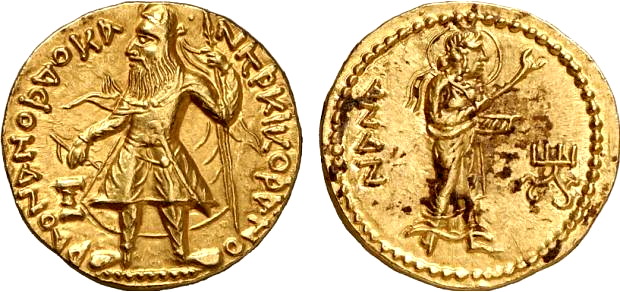
Kanishka I (the great)
128-154 AD
Gold Dinar
Obverse: King looking left, Sacrificing at Altar with his right hand, left hand
holding bow. Legends are in Bactrian. Flames emerging from shoulder.
Reverse: Nana standing right, holding sceptre; tamgha to right
Weight: 7.93 gm
GK#35
Scarce
Apart from being a successful warrior, Kanishaka was certainly a man of great taste and superior knowledge. He patronized contemporary intellectuals including sage `Shakya-muni' who had introduced him to Buddhism. Kanishka summoned a great council of contemporary scholars and philosophers to examine the Buddhist scriptures and prepare commentaries on them. A celebrated philosopher, poet and dramatist Ashvaghosh who wrote Buddha Charita, was in his court. He built many monuments, the most celebrated of all is the great Chaitya (Shah-ji-ki-dheri stupa) at his capital Purushpur (Peshawar, which is located near the capital of modern Pakistan) which have been admired by many travellers down to late period. Chinese travellers Fa Hsien and Hsuan Tsang wrote detail description of Kanishaka's temple building activity in Taxila and Gandhara (modern Pakistan).
Kanishka I (the great)
128-154 AD
Copper Tetradrachm
Obverse: King sacrificing at altar
Reverse: Buddha Maitraya seated
Weight: ~16 gm
Rare
His coinage bear eloquent testimony to his zeal for Buddhism. Lord Shiva and bull, Nandi were commonly portrayed on his gold and copper coins, but the most important numismatic contribution of him is as follows: he was the first ruler (and perhaps only one in ancient world) who minted coins with image of Buddha. The coins depicting Buddha are extremely rare. There exist only 5 gold coins (2 dinars and 3 quarter dinars) in the world having portrait of Buddha. There are some copper coins which show Buddha which are also rare. All these coins have been minted by Kanishka, most likely to commomerate building of great stupa of Purushpur (modern Peshawar, in Pakistan). There are two types of Buddha's coins, Standing Buddha, Gautam, and sitting Buddha, Maitraya. Shown above is a very good example of Kanishka's coin portraying him sacrificing at altar on obverse, while reverse shows Buddha sitting in his Abhaydan pose. Also Shown below is another specimen where one can see standing Buddha on reverse of his coin.
Kanishka I (the great)
128-154 AD
Copper Tetradrachm
Obverse: King sacrificing at altar
Reverse: Buddha Goutam standing
Weight: ~15 gm
Rare
Kanishka minted gold and copper coins. Gold coins were minted in two denominations; Dinar and quarter Dinars.Quarter Dinars are rare and beautiful example of miniature art. Two such examples are shown below:
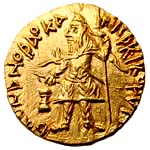

Kanishka I (the great)
128-154 AD
Gold Quarter Dinar
Obverse: King standing left, right shoulder flaming, cloak flying,
sacrificing over altar and holding goad in right hand and spear in left.
Legends are in Bactrian.
Reverse: Nanashao, nimbate, standing right, holding scepter in right hand
and box in left, tamgha in right field.
Weight: 1.99 gms
GK#50
Very Rare
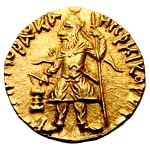
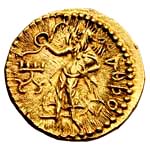
Kanishka I (the great)
128-154 AD
Gold Quarter Dinar
Obverse: King standing left, right shoulder flaming, cloak flying, sacrificing over altar and holding
goad in right hand and spear in left. Legends are in Bactrian.
Reverse: Athsho, god of fire, standing left, holding wreath in extended right hand, tamgha below
in left field
Weight: 2.01 gms
GK#47
Very Rare
HUVISHKA (154-192 AD)
Huvishka succeeded Kanishka I. The record of his reign has been unearthed at Wardak, near Kabul. Huvishka built many magnificent monuments at Mathura. He was founder of a city Hushka in Kashmir named after him (described by Kalhan in Rajatarangini). Kushana empire was at its zenith during Kanishka's and Huvishka's reign. Huvishka took many titles including `Devaputra' (son of god) and perhaps was a patron of Mathura school of art. Dozens of breathtaking examples of this school of art can still be seen at Mathura museum .

Huvishka
154-192 AD
Gold Dinar
Obverse: Half length profile Bust of King to left, emerging from clouds,
wearing rounded helmet decorated with antlers and crest ornament, jeweled
yoke and loose fitting tunic. He holds an ornamental mace in his left hand
and Ankusha (elephant goad or royal sceptre) in right. Flames emerge from
right shoulder. King is sporting Galamucha (sideburn). This is an earlier
type of portrait on coin. The Bactrian legend `Shaonano Shao Ooeshki Koshano’
starting at VII position.
Reverse: Four armed Lord Shiva (OHPO) standing to left, symbol in left field.
Shiva holds the Damru (Drum), Kamandalu (Vase) and Ankusha (elephant goad)
in his right hands, the trident in his upper left hand. The lower left hand,
he holds the Mriga, an Indian antelope by horns.
Weight: 7.9 gm
GK# 155.1
Very Rare
Very likely, Huvishka was a sophisticated ruler. His cosmopolitan outlook is amply eveident in his coinage. His early coins potray him as a warrior, sporting a beard and brandishing weapon (as shown above). But the transition is seen, his later coins show him a handsome king with a imperial crown and bejewelled tunic, having elephant goad/mace in his hand. This transition from a nomadic warrior to a King accustomed to court life of opulance (a specimen of this type shown below), represents the only such example in Indian numismatic history.
Huvishka
154-192 AD
Gold Dinar
Obverse: Bust of King
Reverse: Lunar God Mao with crescent on shoulder
Weight: 7.9 gm
BMC# 30
Very Rare
Huvishka
154-192 AD
Copper unit
Obverse: King riding elephant
Reverse: Lunar God Mao with crescent on shoulder
Weight: 5.65 gm
VASUDEVA I (192-228 AD)
After Huvishka's reign, Vasudeva I took control of this dynasty. Vasudeva I was the last great king of the dynasty when Kushana empire was at it's height of splendor, prosperity and opulence. Most likley, he had his capital at Mathura (in northern India). He too was a patron of art and under his patronage Mathura school of art prospered. By the time of Vasideva I, the Kushan dynasty had been totally assimilated in Indian culture, as reflected in his and his successors coins. All the coins were minted showing either Shiva (Oesho) or Laxmi (Ardoxsho). Never again deity of Greek or Zorostrian pantheon was used by Kushan rulers on their coinage. Majority of Vasideva's coins were minted displaying god Shiva (as Oesho), often holding trident, drum and small Drum, Damaru and his bull, Nandi on reverse. An interesting aspect of his coinage include a series of gold coins minted showing four-armed, three headed Lord Shiva. These are very special coins and are highly sought after. The minute details of physical appearance displayed on these gold coins while portraying Lord Shiva (and his side heads) and his bull amply demonstrate the superb skills of die-engravers of Kushan period. Shown below is an excellent example of his coin, which is in mint condition. On obverse is the king shown wearing helmet and in complete regalia, sacrificing at a small altar. The legends are in Bactrian/Kharosthi which are complete and very clear on this coin.
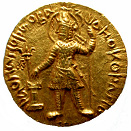
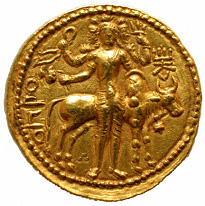
Vasudeva I
192-228 AD
Gold Stater
Weight: 8.05 gms
Obverse: King Sacrificing at Altar with right hand, the left hand holding the trident.
Another trident in the field. The Bactrian legend is around
Reverse: Four-armed, Three-headed Shiva, side heads are human, standing with Nandi,
looking right
Reference: Gobl#506.3
Very Rare
A terracotta Votive panel painted during Vasudeva's reign is unearthed in Bactria (northern Afghanistan). It is currently housed in the Metropolitan Museum of Art (image is shown on top). Hands clasped in adoration of a missing worshipper is seen on right and on left four-armed and three-headed god Shiva/Oesho, with a prominent third eye, is depicted on the panel. He wears an animal skin and a belted, diaphanous garment and holds a trident. The panel have holes at the corners and were probably installed, together with two others (showing Zeus/Serapis/Ohrmazd and Pharro, also in the same Museum), on the interior walls of a sanctuary or a family shrine. It is likely that these striking images have borrowed the divine iconography from contemporary coins, suggesting that these coins were integral part of Kushan cultural fabric.
Vasudeva I
192-228 AD
Gold Stater
Weight: 8.0 gm
MAC#3389
Vasudeva I
192-228 AD
Obverse: Bust of King
Reverse:Hook
Copper war medal
Weight: 48.0 gm
Extremely Rare
ONS
Newsletter #158
KANISHKA II (228-250 AD)
Kushan empire had started its decline soon after Vasudeva's death.
Vasudeva was followed by his son (?) Kanishka II who lost all the territories
west of river Indus to Sassanians. Sassanians princes ruled this region
and called themselves Kushanshahs and minted coins which were influenced
by both Kushan and sassanian style. Kingdom of Kanishaka II consisted of
provinces east of river Indus, Taxila (modern Pakistan), Punjab and region
around Mathura (northern India). His coinage can be divided into two
types:
(1)Goddess Ardoksho (Laxmi) on reverse minted at Mathura
(2)Shiva and Nandi on reverse minted at Taxila
Kanishka II
228-250 AD
Obverse: King Sacrificing at Altar
Reverse: Three-headed Shiva
Gold Stater
Weight: 7.8 gm
GK# 635.7
Extremely Rare
ONS
Newsletter #156
Unlike his predecessors, Kanishaka II and kings who followed him (Vasudeva II, Vashishka, Shaka and many more) minted coins bears Bramhi characters. Shown above is fine example of Kanishaka II coin which depict king sacrificing at altar on obverse and three-headed shiva with his bull Nandi on reverse. Most early Kushan emperors minted coins depicting Shiva but coins showing three-headed Shiva (2, 4 or 6 armed) were known to be minted by only Huvishka and Vasudeva I. However with this coin it became apparent that even Kanishaka II minted three-headed Shiva depicting coins, the fact that was overlooked in early literature.
VASHISHKA (250-268 AD)

Vashishka
250-268 AD
Obverse: King Sacrificing at Altar
Reverse: Shiva
Gold Stater
Weight: 7.85 gm
GK#
Scarce
Vashishaka was last major ruler of Kushan dynasty. His coin depicting Shiva is shown above. After Vashishka the Kushan empire had completly disintegrated into few smaller kingdoms. By fourth century AD this dynasty went into total obscurity with advent of mighty Gupta emperors.
This section is currently under construction. I am putting together more
images of coins and lot more interesting information. Come back soon!
If you have any comments, please send at
This page is divided into following sections: